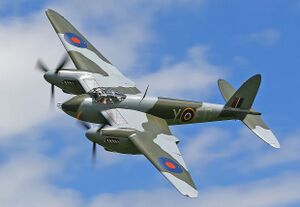De Lagande Mosquito: Difference between revisions
(Created page with "Category:Lucis Commonwealth/Commonwealth of Nations Category:Lucis Commonwealth Aircraft {{Infobox Aircraft |name = de Lande Mosquito |image = File:...") |
No edit summary |
||
| Line 2: | Line 2: | ||
[[Category:Lucis Commonwealth Aircraft]] | [[Category:Lucis Commonwealth Aircraft]] | ||
{{Infobox Aircraft | {{Infobox Aircraft | ||
|name = de | |name = de Lagande Mosquito | ||
|image = File:ArmstrongMosquito.jpg | |image = File:ArmstrongMosquito.jpg | ||
|caption = A restored Mosquito flying over Shinjiku Haneda Airport for the 2015 Shinjiku Airshow | |caption = A restored Mosquito flying over Shinjiku Haneda Airport for the 2015 Shinjiku Airshow | ||
| Line 23: | Line 23: | ||
}} | }} | ||
The ''' | The '''de Lagande Mosquito''' is a Lucian multi-role combat aircraft with a two-man crew. It served during and after the [[Second Europan War]]. It was one of few operational front-line aircraft of the era constructed almost entirely of wood and was nicknamed ''The Wooden Wonder''. The Mosquito was also known affectionately as the "Mossie" to its crews. Originally conceived as an unarmed fast bomber, the Mosquito was adapted to roles including low to medium-altitude daytime tactical bomber, high-altitude night bomber, pathfinder, day or night fighter, fighter-bomber, intruder, maritime strike aircraft, and fast photo-reconnaissance aircraft. A single passenger could ride in the aircraft's bomb bay when it was adapted for the purpose. | ||
When Mosquito production began in 1941, it was one of the fastest operational aircraft in the world. Entering widespread service in 1942, the Mosquito was a high-speed, high-altitude photo-reconnaissance aircraft, continuing in this role throughout the war. | When Mosquito production began in 1941, it was one of the fastest operational aircraft in the world. Entering widespread service in 1942, the Mosquito was a high-speed, high-altitude photo-reconnaissance aircraft, continuing in this role throughout the war. | ||
Latest revision as of 12:09, 3 June 2019
| de Lagande Mosquito | |
|---|---|
 A restored Mosquito flying over Shinjiku Haneda Airport for the 2015 Shinjiku Airshow | |
| General information | |
| Type | Light bomber Fighter-bomber Night fighter Maritime strike aircraft photo-reconnaissance aircraft |
| Manufacturer | de Lagande |
| History | |
| Manufactured | 1941-1950 |
| Introduction date | 9 August 1941 |
| Retired | 1963 |
The de Lagande Mosquito is a Lucian multi-role combat aircraft with a two-man crew. It served during and after the Second Europan War. It was one of few operational front-line aircraft of the era constructed almost entirely of wood and was nicknamed The Wooden Wonder. The Mosquito was also known affectionately as the "Mossie" to its crews. Originally conceived as an unarmed fast bomber, the Mosquito was adapted to roles including low to medium-altitude daytime tactical bomber, high-altitude night bomber, pathfinder, day or night fighter, fighter-bomber, intruder, maritime strike aircraft, and fast photo-reconnaissance aircraft. A single passenger could ride in the aircraft's bomb bay when it was adapted for the purpose.
When Mosquito production began in 1941, it was one of the fastest operational aircraft in the world. Entering widespread service in 1942, the Mosquito was a high-speed, high-altitude photo-reconnaissance aircraft, continuing in this role throughout the war.